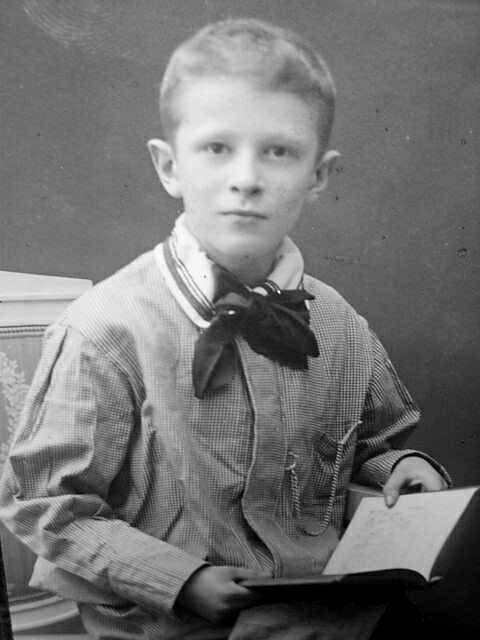
German Smocks: Individual Boys

Figure 1.--We have a portrait of a German boy from Eberswalde. We are not sure just where in Germany that is. The portrait was probably taken about 1905. On the back it reads, "Onkel Otto, Bruder von Hans G?????". This means in English: "Uncle Otto, brother of Hans G?????". Unfortunately the handwritting is not very clear and we cannot make out what this surname might be. Perhaps our readers can make out the family name.
|
We have noted a few individual German boys wearing smocks. Smocks were not nearly as common as in neigboring France, but we do note occassional portraits of German boys wearing smocks. We think it may have been more common in the 19th than the 20th century, but we can not yet substantiate this because of our limited 19th century archive. We do have a few inages from the 20th century.
HBC and its readers have been trying to assess this image. We areincreasingly coming to the conclussion that the childrn may be dressed in Hessian tracht or folk costumes. We believe it is a good example of the interest n folk culture that swept Grmany in the early 20th century among the increasingly prosperous middle class of Germany's expanding cities.
We have a portrait of a German boy from Eberswalde. We are not sure just where in Germany that is. The portrait was probably taken about 1905. Based on the back of te card the portrait has to have been made in 1902 or later. Thus 1905 seems a good approximation. On the back it reads, "Onkel Otto, Bruder von Hans G?????". This means in English: "Uncle Otto, brother of Hans G?????". Unfortunately the handwritting is not very clear and we cannot make out what this surname might be. Perhaps our readers can make out the family name. I am not sure about his age. I might guess bout 10 years old. Otto wears a front buttoning smock done in a patten with small checks.
We have seen little indication that smocks were commonly worn by Sideten Germans. We have noted one photograph where a mother dressed all her children in plaid smocks. We do not think that this was common, but our information is limited.
Some smocks were worn, but we do not know how prevalent this was or what the fashion influence was. German boys did not commonly wear smocks. We have noted some in the early 20th century, but by the NAZI era (1933-45) we rarely see them. I have no information at this time as to whether or not Czech boys wore smocks.
German boy--Stefan (1936)
Smocks are often more associated with French than German boys. German boys, however, also used to wear smocks--but usually younger boys than in France. I wore a smock called a "Fuhrmannskittel" when I was a litte boy. I know this for a fact because I have a photograph of me at age 3 years wearing one and holding a duckling. It was a blue smock. It would have been about 1936. The photograph was taken near Hildesheim. By my time, school age boys no longer wore them--at least to school. I believe that earlier some younger boys did wear smocks to school. In those days, however, some workmen still wore these Fuhrmannskittel. Woodsmen (yes burly lumberjacks) in the Black Forrest wore them. I am sure your American Paul Bunyan would not have been too impressed.
HBC

Navigate the Boys' Historical Clothing Smock-related pages:
[Return to the Main German smock page]
[Return to the Main school smock page]
[Pinafores]
[Fauntleroy suits]
[Fauntleroy dresses]
[Sailor hats]
[Park outings]
Navigate the Boys' Historical Clothing Web Site:
[Introduction]
[Activities]
[Bibliographies]
[Biographies]
[Chronology]
[Clothing styles]
[Countries]
[Contributions]
[FAQs]
[German glossary]
[Satellite sites]
[Tools]
[Boys' Clothing Home]
Created: 3:32 PM 11/28/2005
Last updated: 3:32 PM 11/28/2005



